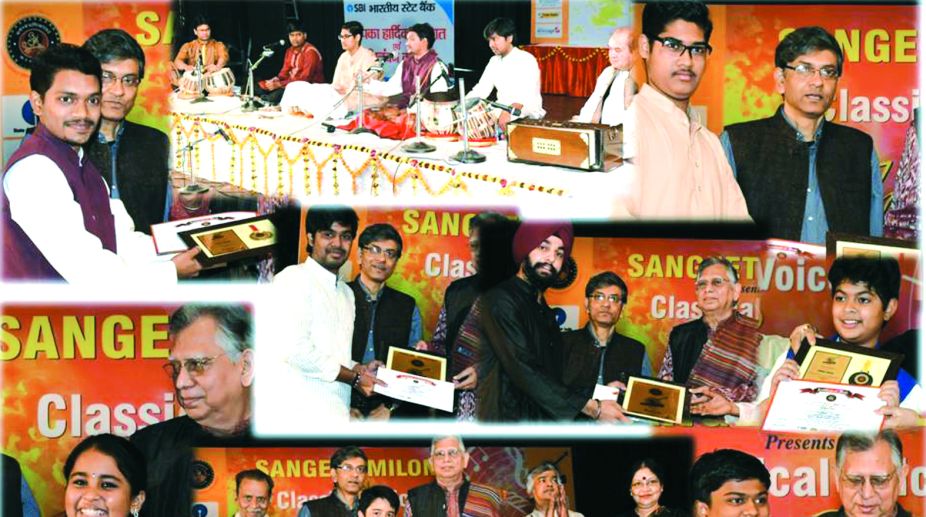Kamarpukur Ramakrishna Math and Mission celebrates Kalpataru Utsav
Kamarpukur Math and Mission celebrated the traditional Kalpataru Utsav with the traditional rituals.

All roads led to Nazrul Manch to see the handsome “God of table” Ustad Zakir Hussain, also known for his onstage warmth, wit and humour, in the final session of the Swara Samrat Music Festival organised by Shree Ranjani Foundation Trust as a star-accompanist to flautist Rakesh Chaurasia.
The fest, dedicated to Swara Samrat Ustad Ali Akbar Khan, a diehard traditionalist groomed by his father Baba Alauddin Khan, proved that the present state of metropolitan confinement is affecting several important aspects of Indian musical tradition.
Chaurasia, nephew-disciple of Pandit Hariprasad Chaurasia, treated raga Bageshri with staccato note-oriented alap and gatkari, shorn of its raga-ness.
Advertisement
The veteran tabla maestro offered special effects from an electronic hand-sonic, placed behind the pair of tabla. It was evident that the musical thoughts of an iconic figure like the Ustad is now determined by urban culture and he is packaging Indo-Western music to lure the Westernised younger generations, who abhor what they do not understand but get easily allured by the thrilling rhythm based trendy melody.
Converse to traditional Indian concept the staccato movements coerce the ragas into mere scales. Ultra-high speed utterings’of sol-fa patterns often miss accurate notes; but the speed makes them so short-lived that only a discerning ear can detect the failings.
The other star-musicians of the fest, vocalist Kaushiki Chakraborty (raga Multani, Yaman tillana and Majh Khamaj thumri with Subhankar Banerjee (tabla) and Rupashree Bhattacharya (harmonium) and sitarist Purbayan Chatterjee (raga Marwa, Majh Khamaj with Pandit Anindo Chatterjee (tabla), are known speedsters and are hot favourites now.
Celeb dhrupad exponents Gundecha Brothers delineated raga Patdeep (sampoorna alap, chautal and fast shooltal compositions with Akhilesh Gundecha (pakhawaj)) with the sensibilities of Dagar Tradition with a stamp of their own.
The mandolin jugalbandi between U Rajesh and Snehashish Majumdar, ably supported by SV Ramani (mridangam) and Ojas Adhiya (tabla), also portrayed a rhythm oriented raga Charukeshi which could do better with more attention on sur.
Traditional fervour
The traditional values of raga-music were devotedly and splendidly presented by Pandit Ulhas Kashalkar (raga Chayanat, slow jhumra and medium teental) followed by a soulful, haunting Bageshri, ably supported by Pandit Suresh Talwalkar’s musical broad-faced tabla. Gourab Chatterjee (harmonium) shadowed the Master unobtrusively. Despite the unwarranted delay earlier, discerning listeners stayed on and requested the erudite maestro to sing a Sohini composition.
Steeped in Jaipur tradition the element of thrill was at its best in Pandit Rajendra Gangani’s kathak recital, superbly supported by Pandit Sanjay Mukherjee’s seasoned tabla. Their “upaj” (instant innovation) based dialogues were electric while the repartees by Mukherjee gifted some beautiful bouquets of bols and tihais with exhilarating finish.
Gangani’s power-packed pieces were interspersed with the gracefully evocative Shiva-stuti, Ganesh paran, ghhonghat ki gat and Desh thumri. Through excellently explicit footwork he depicted heavy rain, light drizzle and single droplets.
Sarod exponent Ken Zukerman too adhered to the cherished raga-tradition while portraying a reposeful Bhimpalasi alap-jod-jhala, followed by teental gatkari in Madhumalati, a raga created by his legendary Ustad, Ali Akbar Khan, and a Bhoop-maand based sweet dhun.
Sangeet Milon
These very traditional values are cherished by Milon Debnath, the beacon of Sangeet Milon, Lucknow, whose sole ambition is to hear little ones sing raga-compositions with love like the way they sing complex film songs. To encourage this among school-goers, “Classical Voice of Lucknow” was conceptualised; and within two years it became a countrywide movement, popularly known as the “Classical Voice of India”, a live audition based contest that unearths amazingly talented young vocalists from all over India since 2013.
Soon, persuaded by Kolkata’s active tabla fraternity, it started another contest “Tabla Nawaz of India” to identify fresh, gifted tabla players.
Despite its bare minimum resources, the organisation covered 22 cities of 12 states in 2017. Through the participants (age group 10-14 years Junior, 15-19 years Middle, 20-24 years Senior and 25-29 years Yuva Kalakar), Sangeet Milon also identifies unknown but dedicated Gurus and extends honour to them.
The finals of both the contests were held at Sant Gadgeji Maharaj auditorium of the regional Sangeet Natak Akademi, Lucknow which saw eminent musicians like Pandits Vidyadhar Vyas, Sarathi Chatterjee (vocals), Parimal Chakraborty (tabla) among several others who evaluated numerous contestants who made it to the finals after topping the city and state level.
Among them Jayantika Dey, Rishav Chakraborty, Dalia Mukherjee, Soubhagya Mohapatra, Sahil Vishe from juniors; Vinayaka M, Upasana Dey, Vasu Gandharva, Asmita Kar, Nishad Harlapur from middle group and Utso Gosh, Akshat Pratap Singh, Vaishnavi Avadhani from seniors displayed immense promise while this year’s “Classical Voice of India” trophy was lifted by Bineet Singh and “Tabla Nawaz of India” trophy by Arun Laha.
Advertisement